This easy Sourdough Bread recipe requires no kneading or folding. The perfect sourdough recipe for beginners. Check out my step by step instructions and recipe video and prepare to fall in love with sourdough!
Did you know you can bake your sourdough bread in an air fryer?
Got sourdough discard to use up? Try my Quick Sourdough Bread With Yeast Sourdough Cheese Scones & Sourdough Blueberry Crumb Cake.
Or how about some super-delicious Easy Sourdough Discard Focaccia with Yeast?
Post may contain affiliate links. For more information, check my disclosure
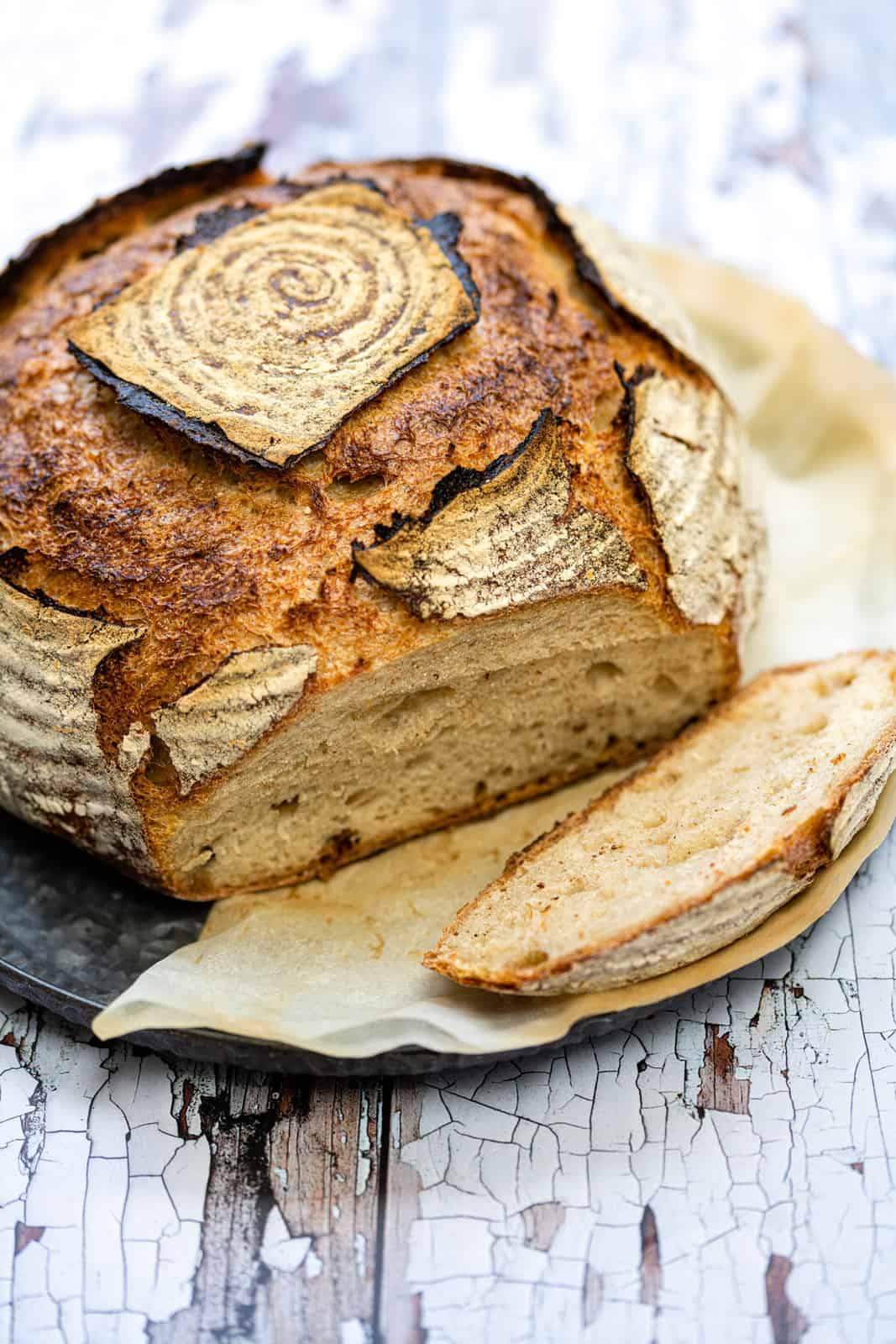
Beginner’s Sourdough Bread
Want to bake your first sourdough bread but feel intimidated and overwhelmed? My simplified method will take you from starter to sourdough bread with about 10 minutes hand on effort.
No kneading, no stretching and folding… this really is the easiest overnight sourdough ever! Make sure to check out the video to see the recipe in action, especially the shaping of the loaf.
Fancy baking a sourdough focaccia? This is another super easy recipe that’s perfect for newbies!
The Sourdough Trend
Like so many others during the bizarre Spring 2020, I decided to nurture a sourdough starter. This was merely an experiment to keep my mind focused and the kids engaged, my hopes weren’t high.
We fed our starter, christened Haku after Spirited Away, dutifully every day for a week. There was some bubbling, but it didn’t really look very active. Then on day 9, when I had just about given up, the starter literally doubled before our astonished eyes. Time to get baking!
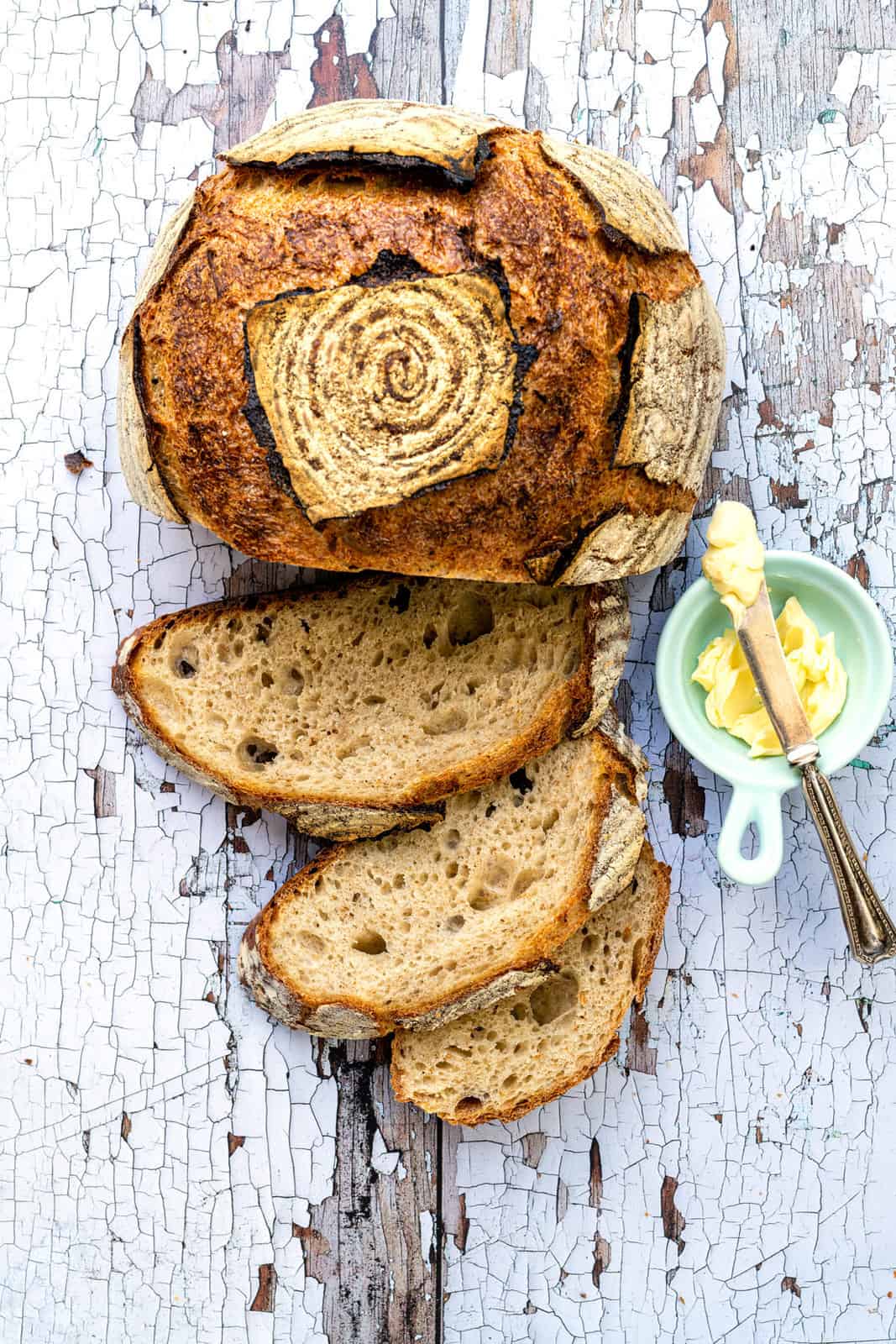
And here is where my mind literally went into screensaver mode. There was so much information about baking sourdough bread, so many new terms to wrap my head around, so much work.
So I decided to tackle my first sourdough bread the same lazy way I bake my no knead bread: mix the ingredients, leave them to do their thing, shape, rise and bake. To my amazement this no knead sourdough worked a treat.
And the wonder and pride you will feel when you cradle your first sourdough loaf is really such a high, you will soon want to bake bread again and again.
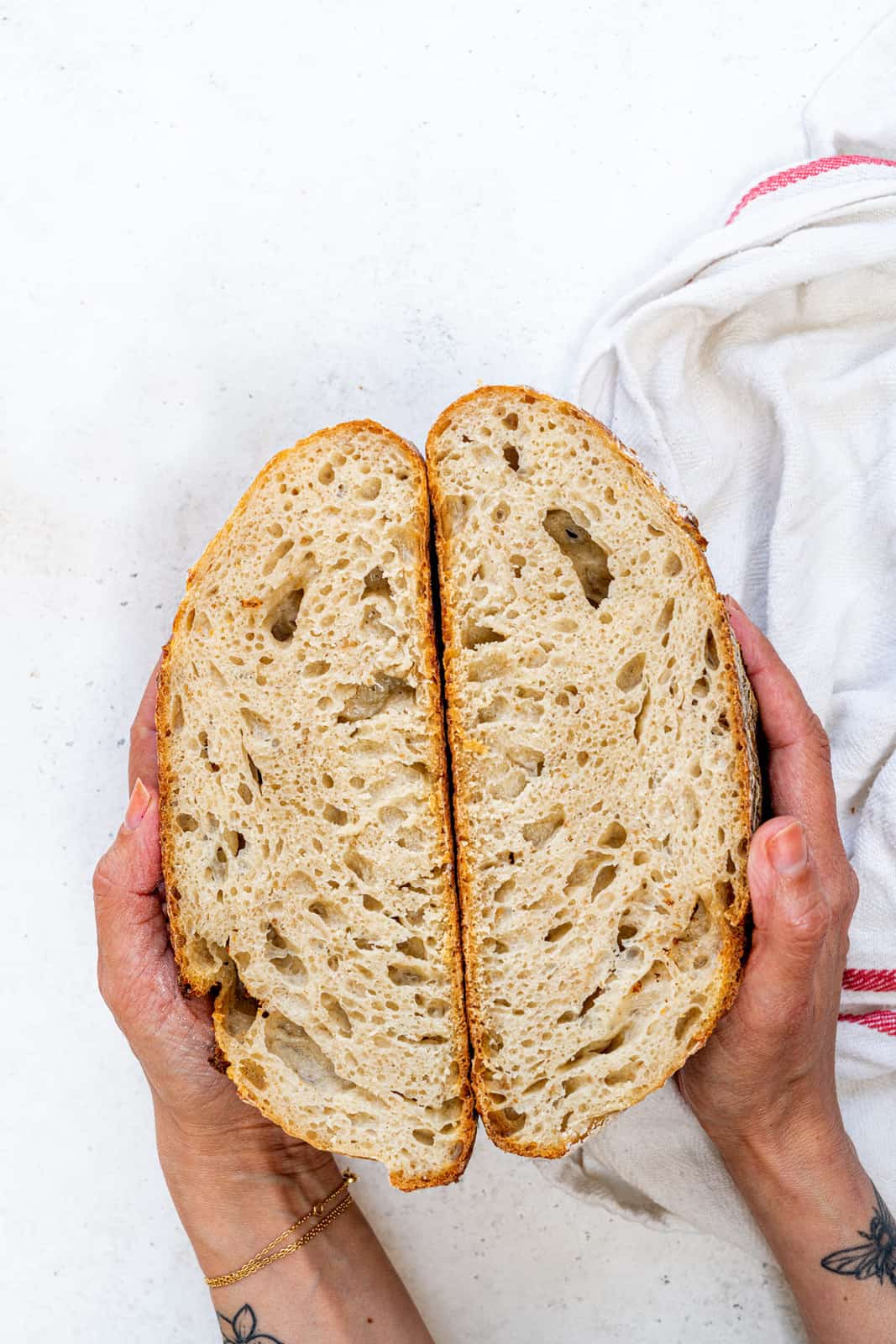
Health Benefits of Sourdough
Sourdough bread tastes infinitely more delicious than insipid commercial bread loaves, but is it good for you?
Sourdough bread is easier to digest, more nutritious and better tolerated than regular bread. This basic sourdough bread recipe is also naturally vegan / vegetarian.
Sourdough bread is NOT, however, gluten-free unless it has been prepared using a gluten free sourdough starter and flour. Take a look at this recipe for Gluten Free Sourdough.
Ingredients
- Active sourdough starter – you can get your starter from a friend, or buy sourdough starter online or from a local bakery. You can also make your own (recipe to follow soon)
- Bread flour – this is higher in protein and will give your loaf a better structure. You can use all purpose (plain) flour but your loaf may not rise as well. For this simple sourdough recipe I have used white bread flour.
- Salt – ideally fine sea salt
- Water – filtered, bottled or tap water*.
*Chlorinated water is thought to inhibit the growth of sourdough starter – I usually boil tap water and leave it to cool before using. - Rice flour or gluten free flour for the bowl
Useful equipment & Tools
- Digital scales are needed for accurate measuring
- Bowl or a banneton basket for proving the dough
- Lame, razor or sharp knife for scoring
- A cast iron pot – I have used my trusty Greenpan Dutch Oven
- Large jar if you are making your own starter (I love these Weck Jars)
- Spatula for mixing your starter
- Dough whisk for mixing bread dough (optional but useful!)
- Bench scraper and small spray bottle
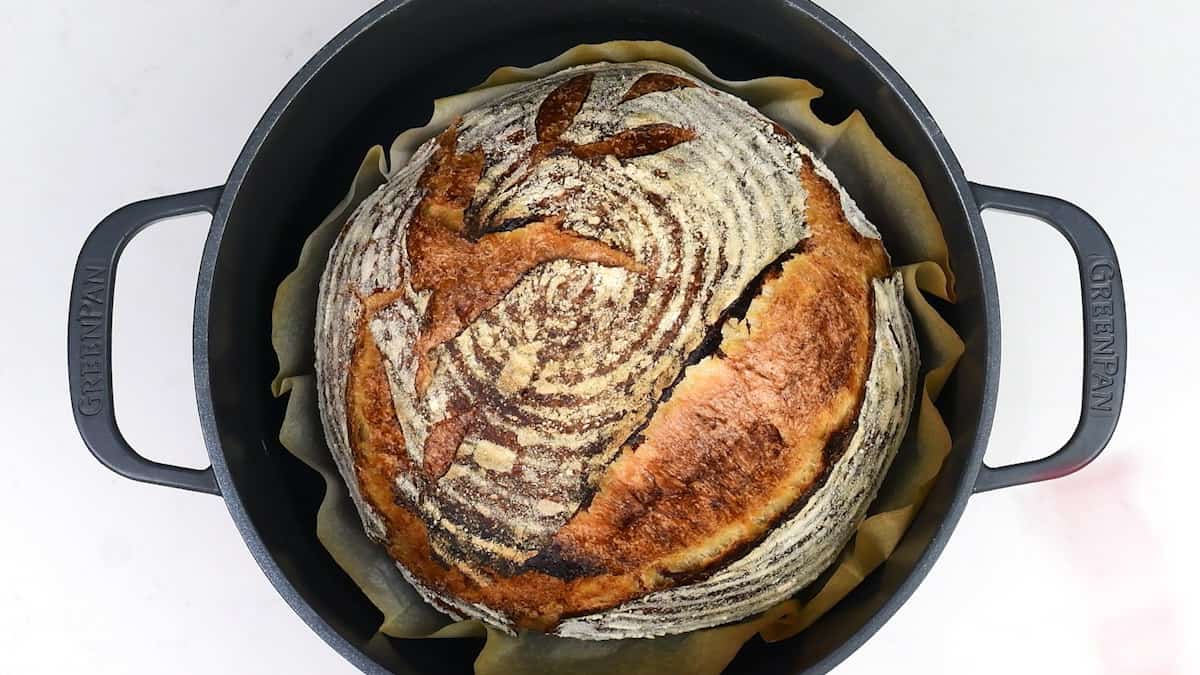
How do I know if my sourdough starter is ready?
An active starter should double in size and be bubbly within a few hours of being fed. To check whether it is ready, add a spoonful of active starter to a glass of water. If it floats you are good to go. If it sinks it’s not quite there yet – this is called the float test.
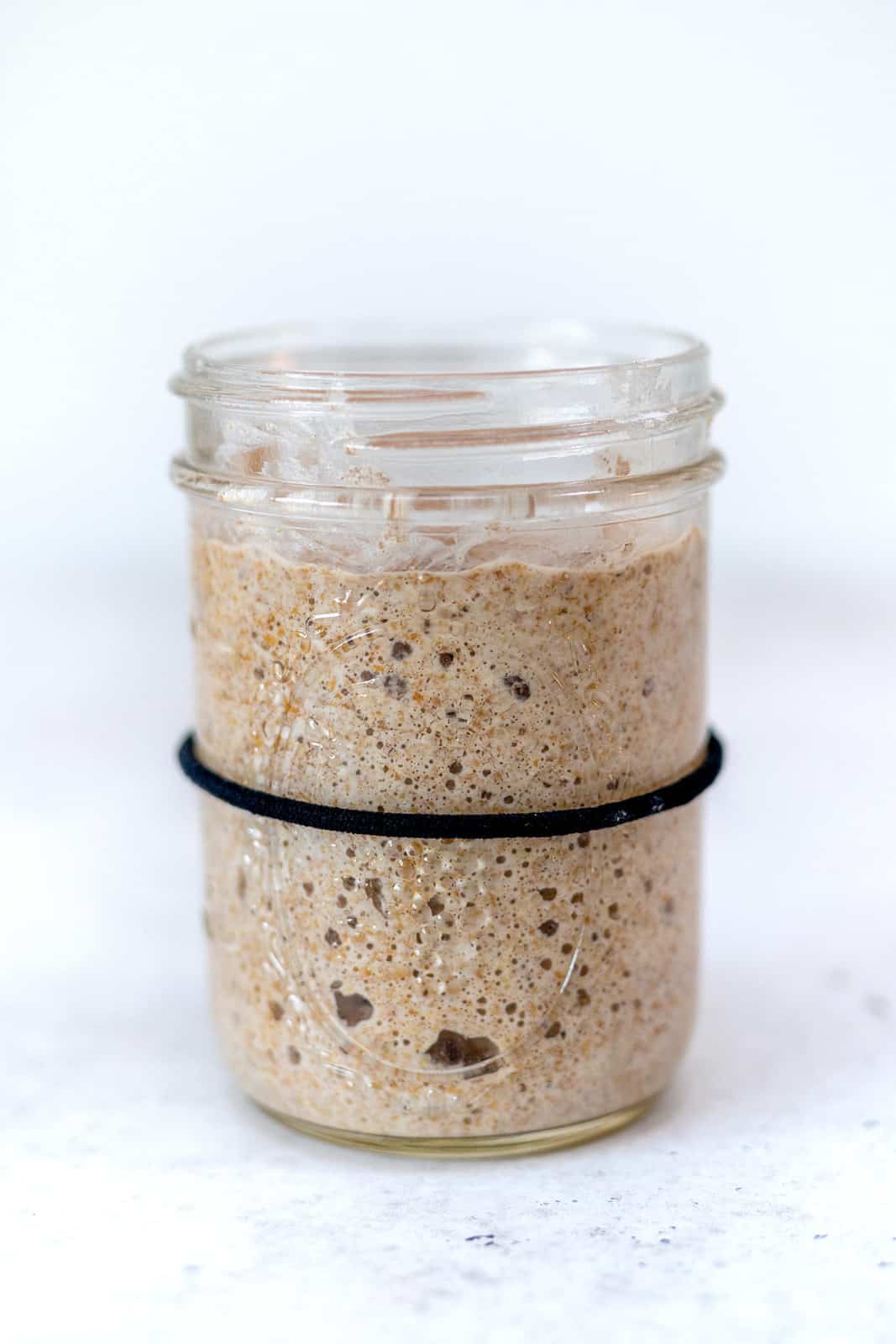
How to Make Sourdough Bread
Full measurements and instructions can be found on the printable recipe card at the bottom of the page. Please take a look at the steps and video before attempting this recipe!
This is my timetable for making overnight sourdough. You can follow your own schedule just keep and eye on the timing. If the weather is particularly warm the bread will prove quite quickly and is in danger of over fermenting – I usually prefer to prove the dough in the fridge overnight for 12 hours or longer.
6pm Feed Your Starter Feed a mature starter then leave for 4 hours, or until doubled in size, bubbly and floating in water (float test). My starter used to take 6-7 hours at first, now that the weather is a lot warmer it’s ready in around 4 hours. Try to use your starter at its peak, before it starts to sink again (you will see a trail on the sides of the jar when it starts to deflate). Don’t forget – always keep some of your active starter in the fridge for further baking!
10pm Mix The Dough Add the bubbly starter in a large mixing bowl. Pour in the water and mix well – I use my dough whisk for this.
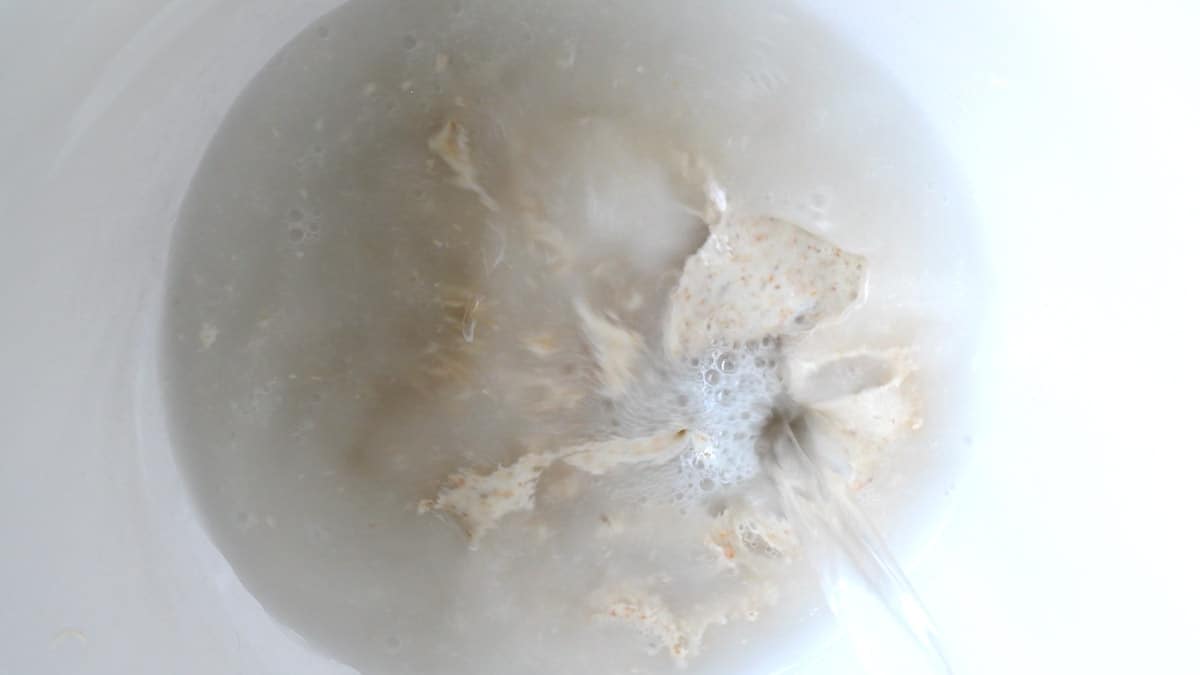
Add the bread flour, salt and mix well with the dough whisk or your hands. It’s easier to have a feel for the dough if you use your hands. You will have a shaggy, slightly sticky dough.
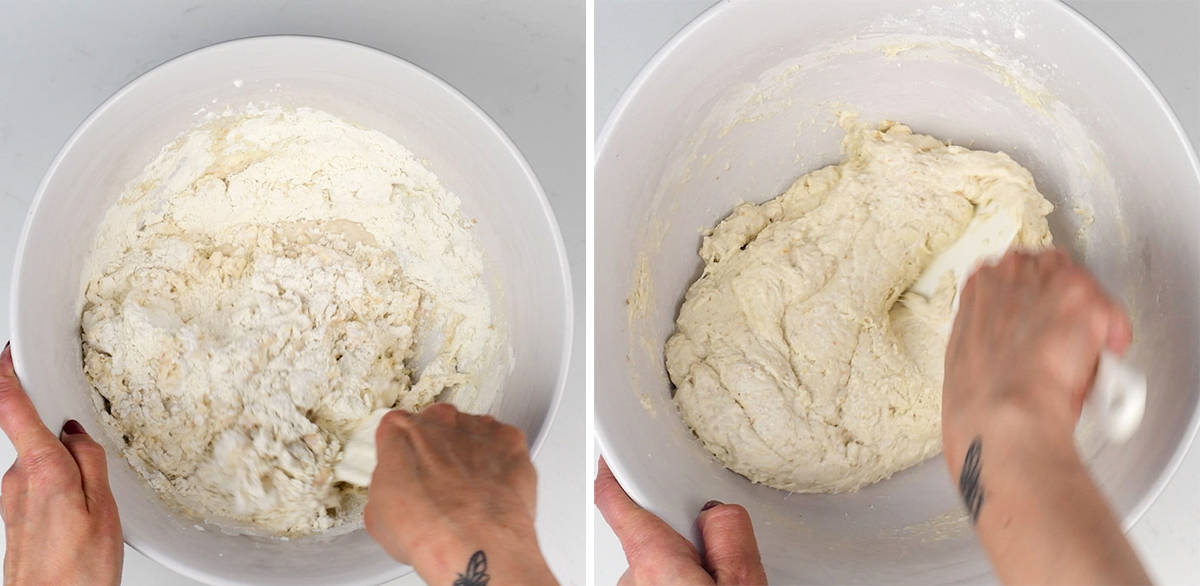
BULK FERMENTATION Transfer the dough into a rectangular container (I like a glass pyrex dish), mist with a little water, cover and leave to rise at room temperature overnight (8-10 hours) or in the fridge (10-12 hours) if it is a warm night.
10 am – READY TO SHAPE Take a look at your dough – it should have risen in the bowl to almost doubled. Mist your worktop with water and scrape the dough onto it – do not punch the dough down. If the dough is really sticky then you can dust the worktop with a little flour – I prefer to use water with this recipe.
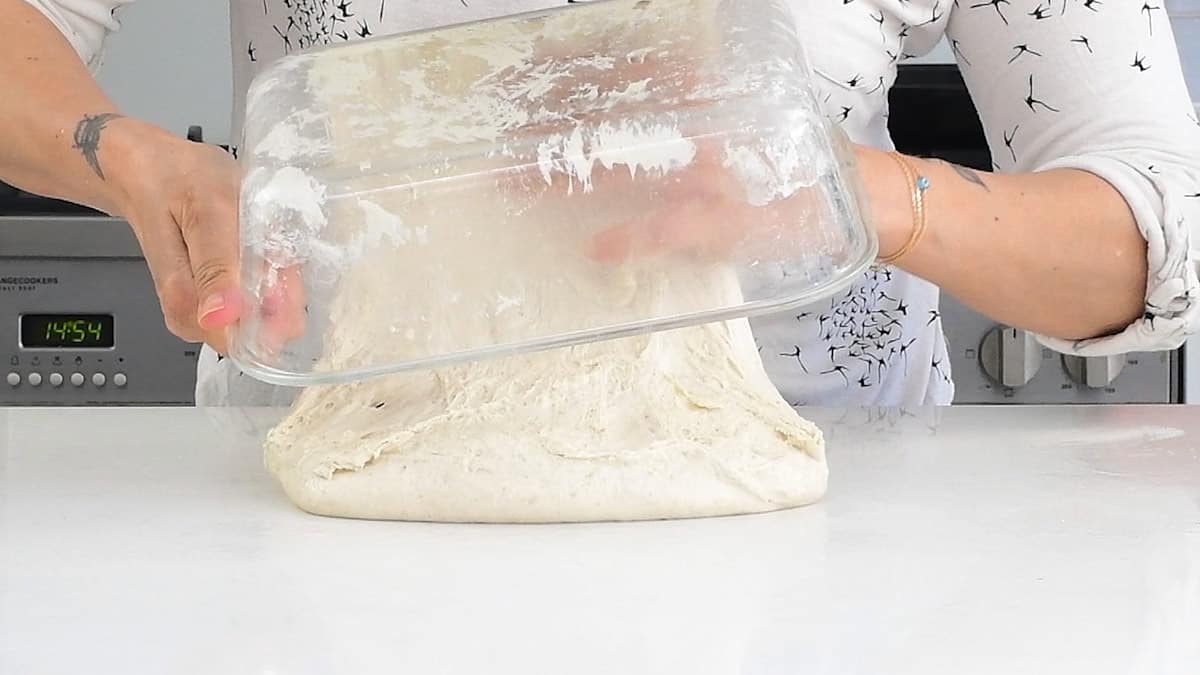
Gently stretch the dough to form a rectangle.
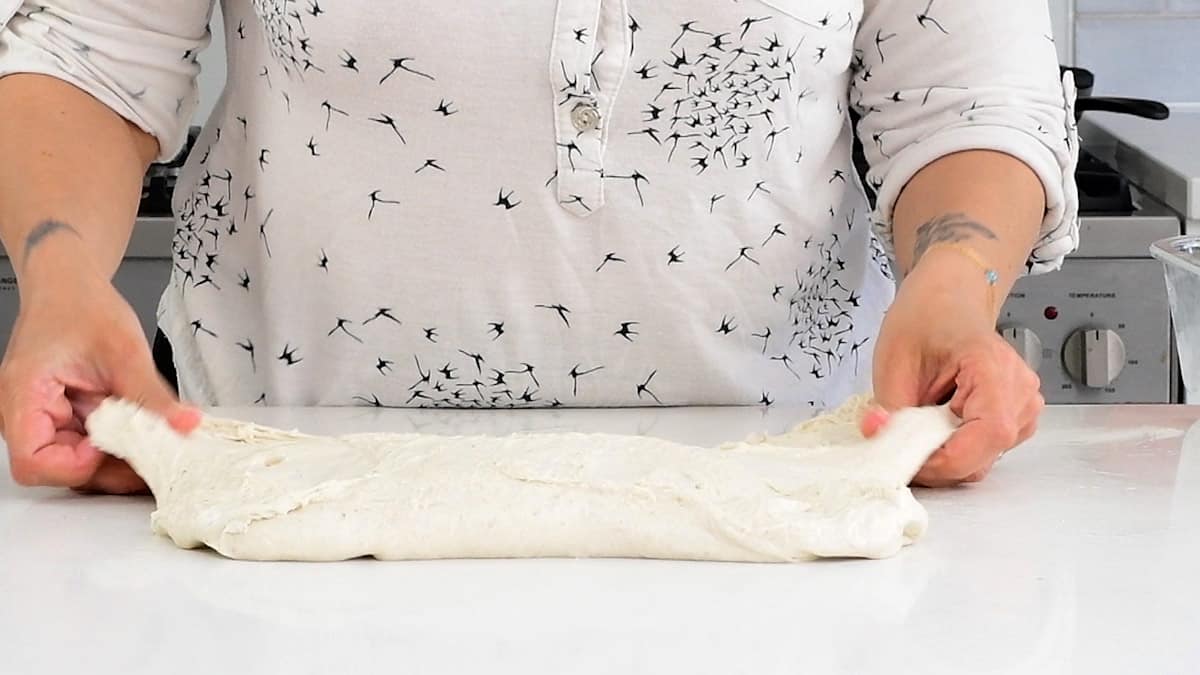
Fold the dough into three sections, like a letter (letter fold).

Roll the dough into a tight ball. It should now stand pretty tall!
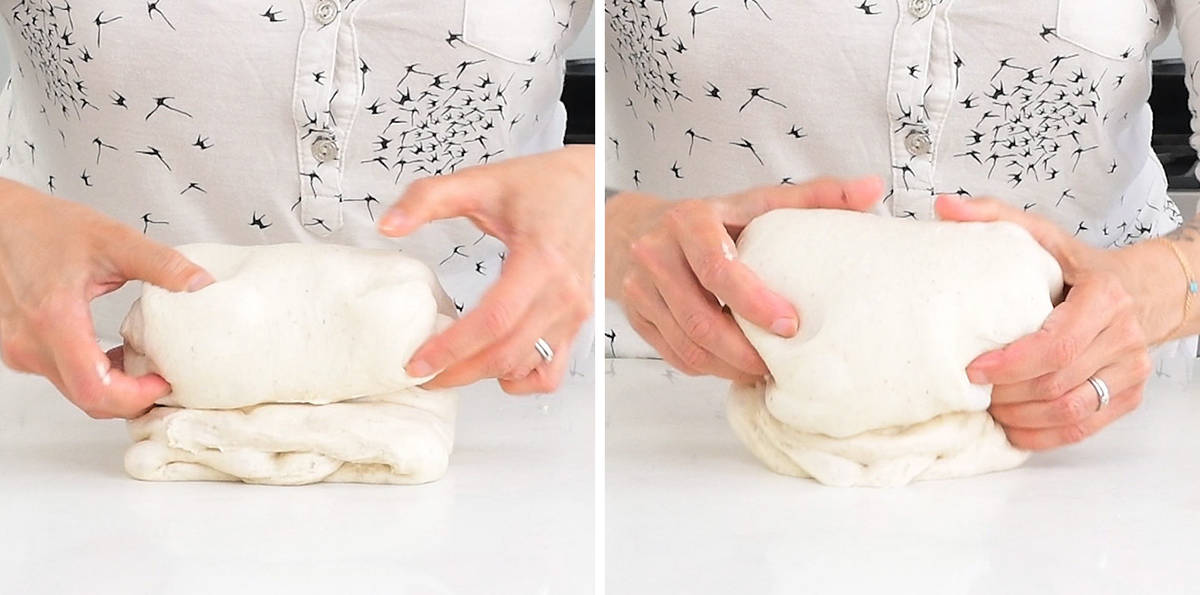
Flip over, seam side down, and shape using your hands and a bench scraper into a round loaf (known as a “boule”). Keep turning on the countertop, shaping between your hands and slightly tucking under until the loaf is smooth.
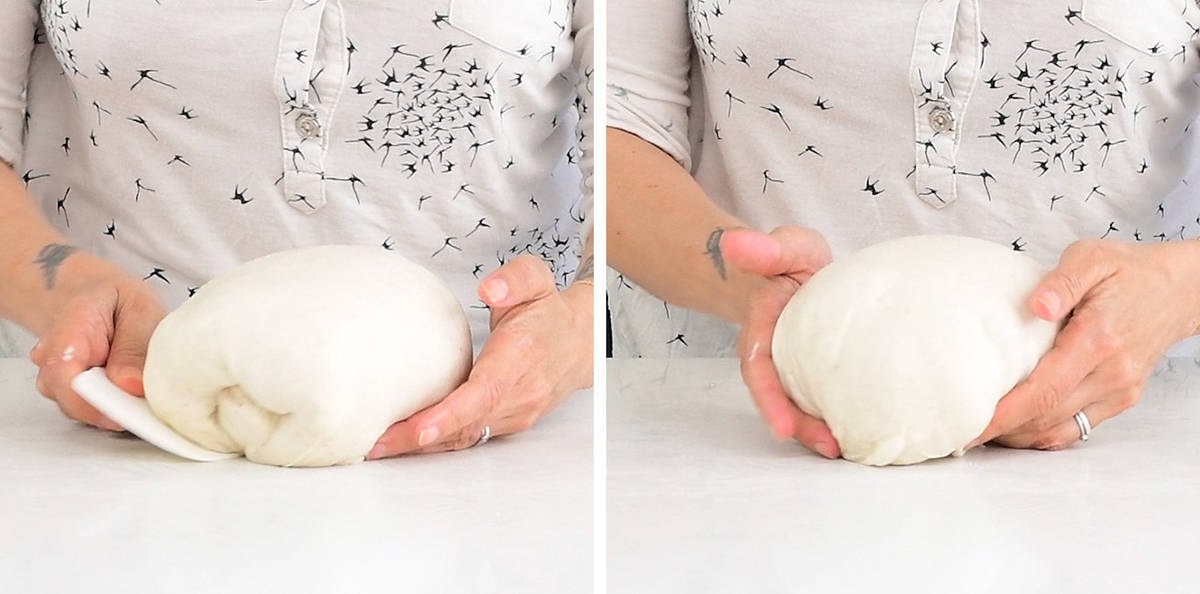
SECOND RISE Line a bowl or basket with baking paper and lightly dust the paper and your loaf with gluten free flour or rice flour to prevent the bread from sticking to the paper.
Place into the prepared bowl seam side down, cover loosely with a plastic bag and leave to rise again for 30 minutes to a couple of hours at room temperature (again, this will be weather dependent).
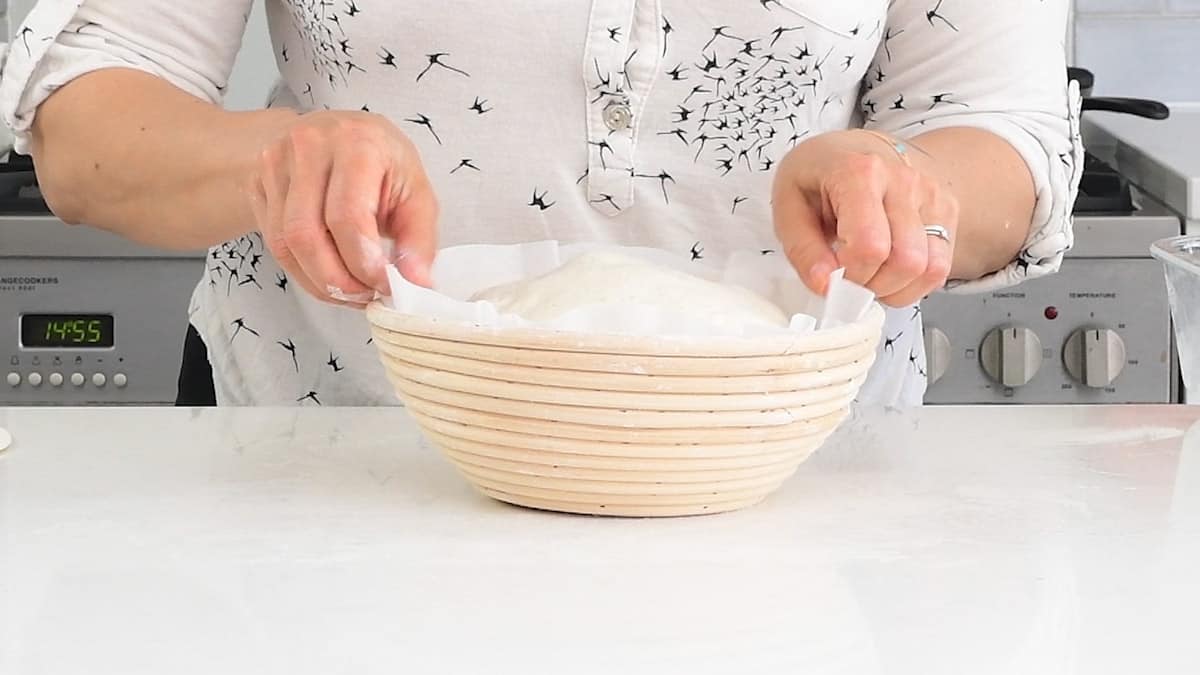
TOP TIP Check your loaf is ready to bake by gently prodding with a finger. If the indent springs back slowly leaving a small dent then you are ready to bake. If it springs back really quickly you need to allow it to rise for a little longer.
BAKE YOUR SOURDOUGH Preheat your oven to 450F (230C) half an hour before the end of proving. Place a lidded pot (Dutch Oven) in the oven to preheat. Score the top of your loaf using a sharp knife, razor or lame.
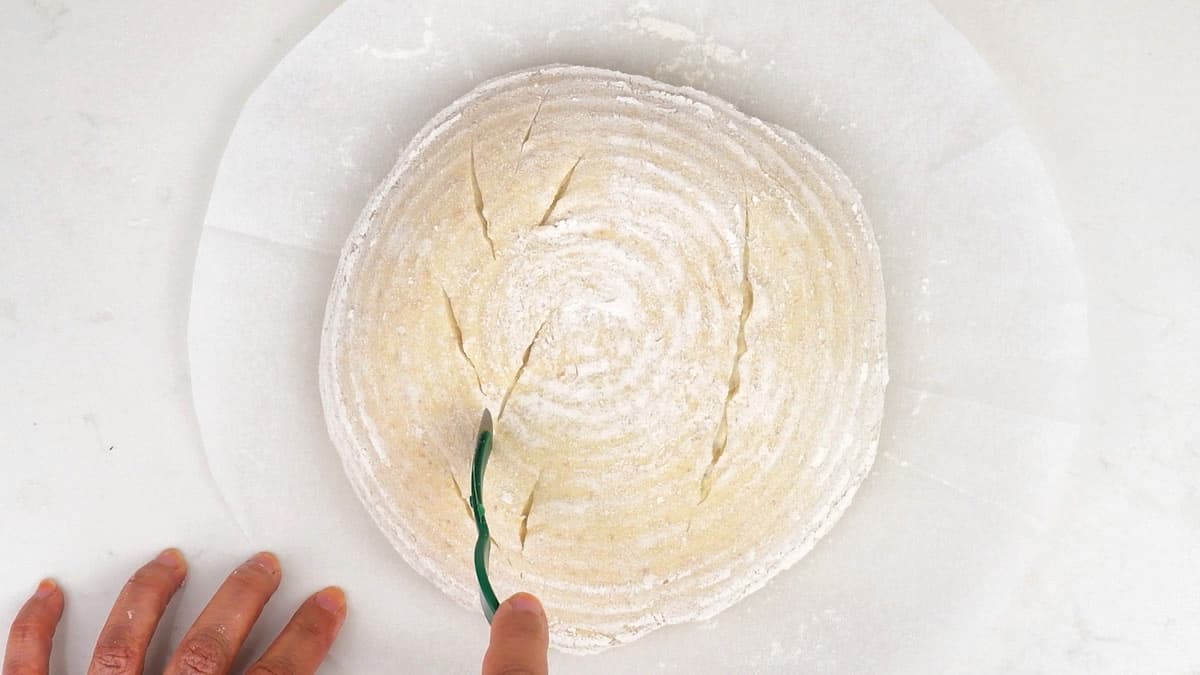
Remove the pot from the oven using pot holders (please be very careful). Carefully place the dough into the pot, lifting it by the baking paper. Cover and bake for 20 minutes.
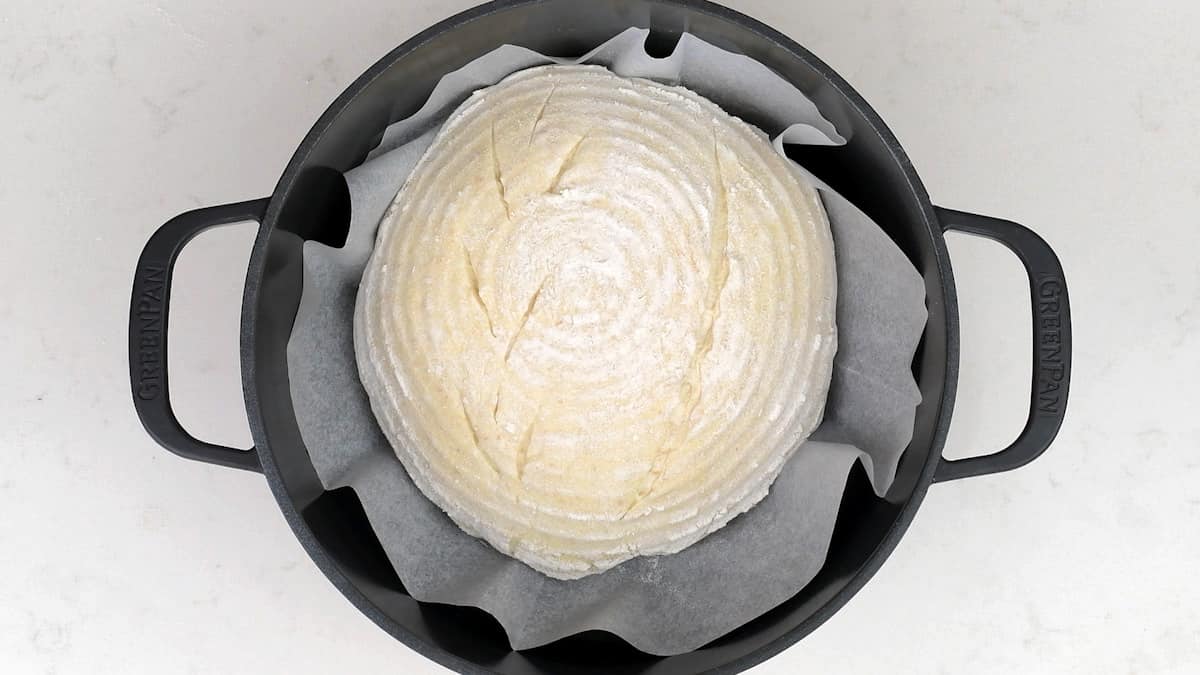
Reduce the oven temperature to 425F (220C). Take the lid off the pot and cook for another 20-25 minutes. You can lift the bread out of the pot and cook directly on the oven shelf for the final 5 minutes.
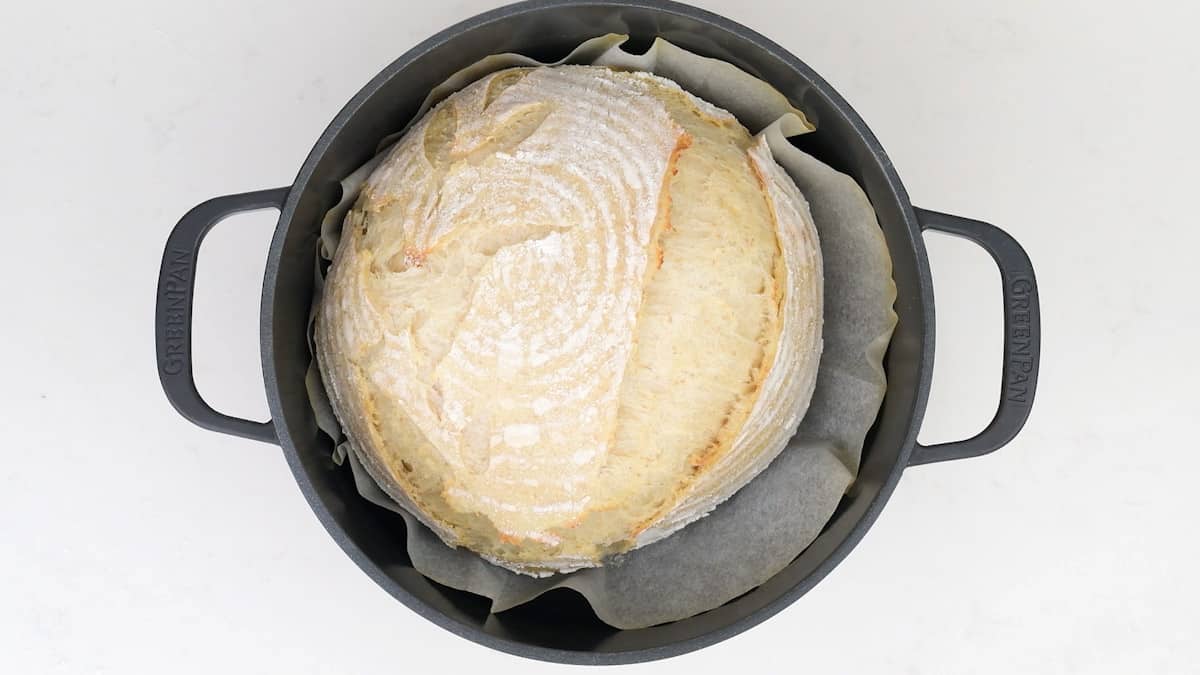
Cool the bread on a wire rack for at least an hour before slicing. Enjoy toasted spread with some salted butter – DELICIOUS!
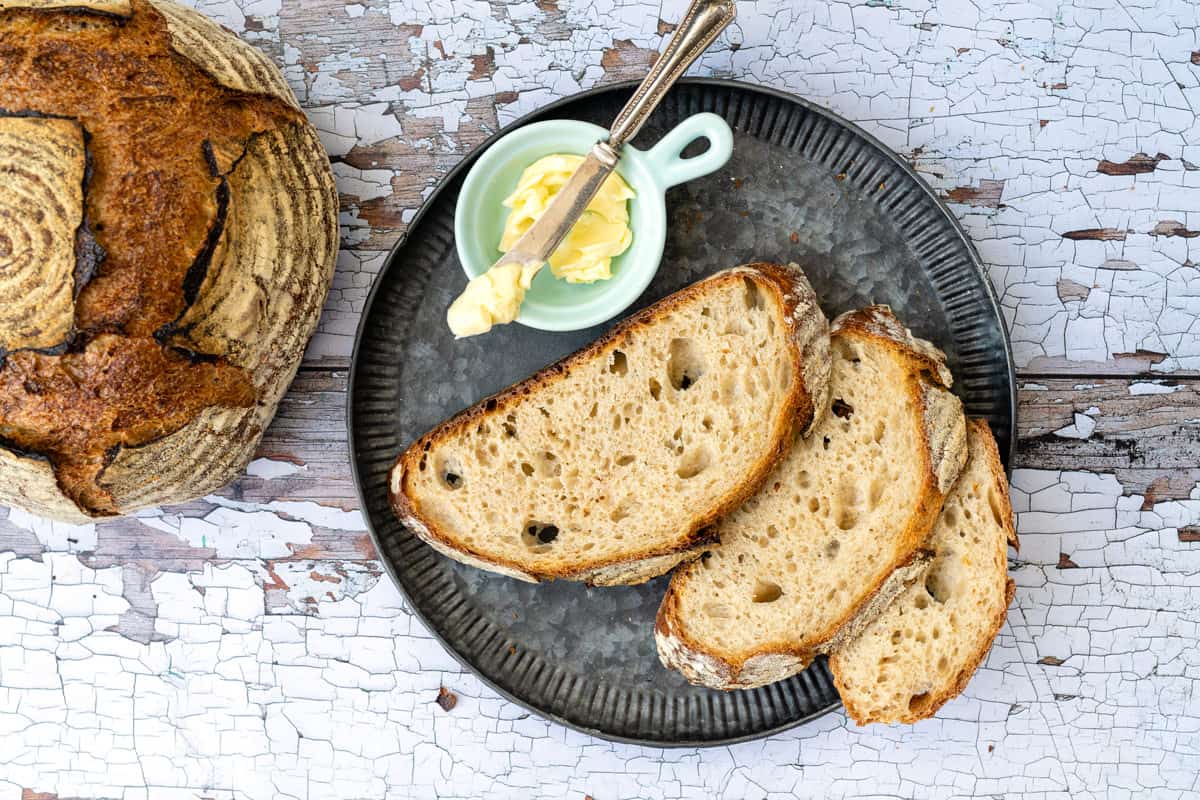
Using a Banneton Basket
If you are using a proofing basket bread basket you will need to prep this first before first use – check this guide for preparing your banneton basket. Dust the basket with rice flour or gluten free flour, shaking out the excess.
Carefully transfer your loaf seam side up directly into the prepared basket. Dust with a little flour, cover with a bag and leave to rise. When the dough is ready to bake, after the second rise, carefully invert onto baking paper then proceed to score and bake in a Dutch Oven.
If you have never made sourdough bread before, it would be best to try the lined bowl method first as it is easier.
Storing Sourdough Bread
Cover the cooled loaf in a clean tea towel and store at room temperature – the bread will keep for 2-3 days.
I prefer to slice the entire loaf and then freeze it – that way you can toast slices directly from frozen whenever the fancy takes you.
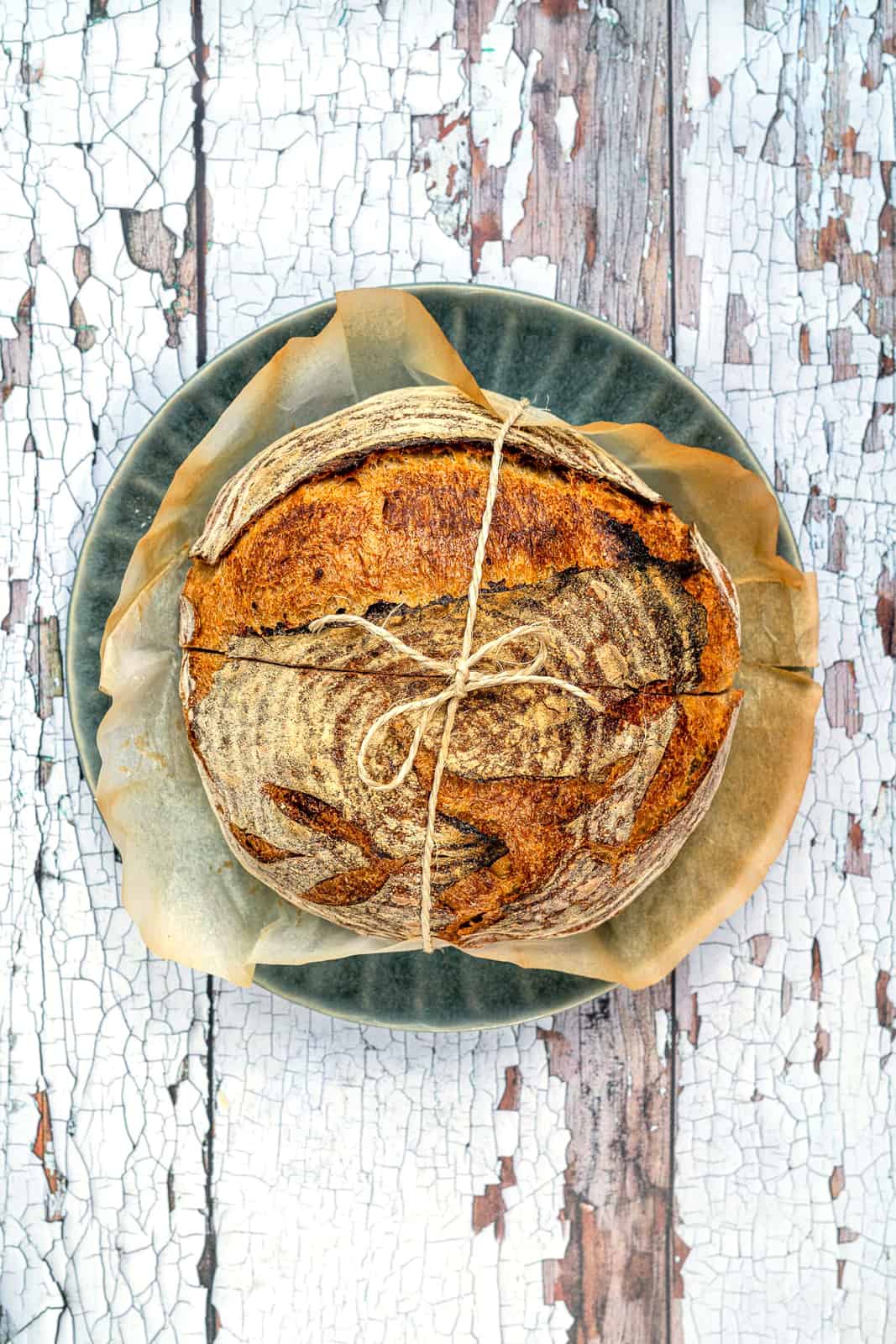
Further Reading
Once you master this basic sourdough recipe you might want to delve deeper into sourdough techniques. Check out these helpful links
- How to shape a boule
- How to check your sourdough has finished proofing
- Sourdough Hydration Explained
TRY THESE DELICIOUS SOURDOUGH RECIPES!
Sourdough Hot Cross Buns

Cinnamon Raisin Sourdough Bread

Sourdough Blueberry Crumb Cake
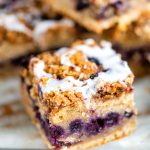
Easy Sourdough Focaccia

HAVE YOU MADE MY OVERNIGHT SOURDOUGH BREAD RECIPE? Post a photo on my Facebook page, share it on Instagram, or save it to Pinterest with the tag #supergoldenbakes and make my day!
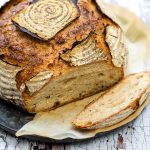
Overnight Sourdough Bread
Ingredients
For your starter
- 60 g (¼ cup) mature starter room temperature
- 60 g (¼ cup) flour
- 60 g (¼ cup) tepid water (filtered, bottled or boiled and cooled tap water)
For the overnight sourdough
- 150 g active starter (most of the starter you prepared earlier)
- 300 g (1 ¼ cups) water (filtered, bottled or boiled and cooled tap water)
- 500 g (4 cups) white bread flour preferably organic
- 12 g (2 tsp) sea salt (2 scant teaspoons)
- rice flour or gluten free flour for the bowl or banetton, as needed
Instructions
Feed Your Sourdough Starter
- Feed 60g of active starter with 60g flour and 60g lukewarm water. Leave for 4-6 hours until doubled in size, bubbly and floating in water (float test).
Prepare The Bread Dough
- Add 150g of bubbly starter in a large mixing bowl. Pour in 300g of water* and mix well – I use my dough whisk. *remember to use filtered, bottled or boiled and cooled tap water.
- Add the bread flour, saltand mix well with the dough whisk or your hands. It’s easier to have a feel for the dough if you use your hands. You will have a shaggy, slightly sticky dough.
- Transfer the dough into a rectangular container (I like a glass pyrex dish), cover and leave to rise at room temperature overnight (8-10 hours). If it is a hot night then place the dough in the fridge where it will need 10-12 hours.
Shape The Sourdough
- The following day take a look at your dough – it should have almost doubled. Mist your worktop with water and scrape the dough onto it – do not punch the dough down. If the dough is really sticky then you can dust the worktop with a little flour – I prefer to use water with this recipe.
- Gently stretch the dough to form a rectangle.
- Fold into three sections, like a letter.
- Roll the dough into a tight ball.
- Flip over, seam side down, and shape into a round loaf (known as a “boule”). Use your hands and a bench scraper to roll the loaf in your hands, slightly tucking the edges under as you go (please check the video for a demo).
Second Rise
- Line a bowl or basket with baking paper and lightly dust the paper and your loaf with gluten free flour or rice flour to prevent the bread from sticking to the paper.
- Gently cup the loaf in your hands and place into the prepared bowl seam side down. Cover loosely with a plastic bag and leave to rise again for 30 minutes to a couple of hours at room temperature (again, this will be temperature dependent).
- Preheat your oven to 450F (230C) half an hour before the end of proving. Place a lidded pot (Dutch Oven) in the oven to preheat.
- Score the top of your loaf using a sharp knife, razor or lame.
Bake your Sourdough
- Remove the pot from the oven using pot holders (please be very careful as it can easily give you very bad burns, as I can testify). Carefully place the dough into the pot, lifting it by the baking paper.
- Cover and bake for 20 minutes.
- Reduce the temperature to 425F (220C). Take the lid off the pot and cook for another 20-25 minutes. You can lift the bread out of the pot and cook directly on the oven shelf for the final 5 minutes.
- Cool the bread on a wire rack for at least an hour before slicing.
Video
Notes
If you are using a banneton basket (you need to prep this first before first use) dust the basket with rice or gluten free flour, shaking out some of the excess. Carefully transfer your load seam side up in this case. Cover with a bag and leave to rise. When the dough is ready to bake, after the second rise, carefully invert onto baking paper then proceed to bake in a Dutch Oven. Storing Sourdough Bread
Cover the cooled loaf in a clean tea towel and store at room temperature – the bread will keep for 2-3 days. I prefer to slice the entire loaf and then freeze it – that way you can toast slices directly from frozen whenever the fancy takes you.
Nutritional Info
ALL IMAGES AND CONTENT ON SUPERGOLDEN BAKES ARE COPYRIGHT PROTECTED. IF YOU WISH TO SHARE THIS RECIPE, THEN PLEASE DO SO BY USING THE SHARE BUTTONS PROVIDED. DO NOT SCREENSHOT / POST RECIPE OR CONTENT IN FULL.

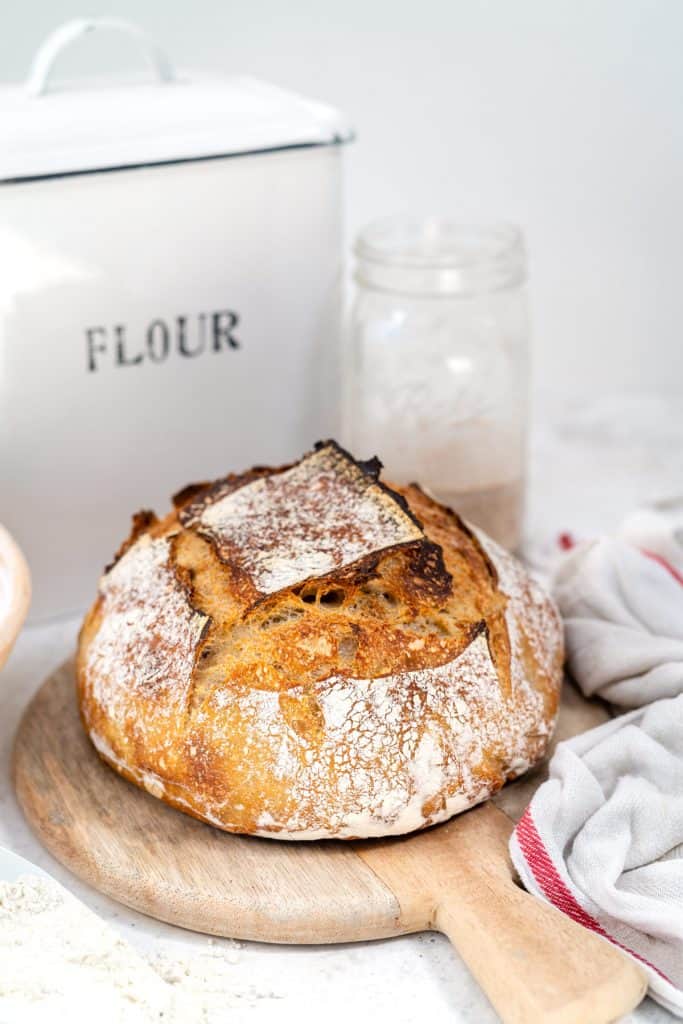
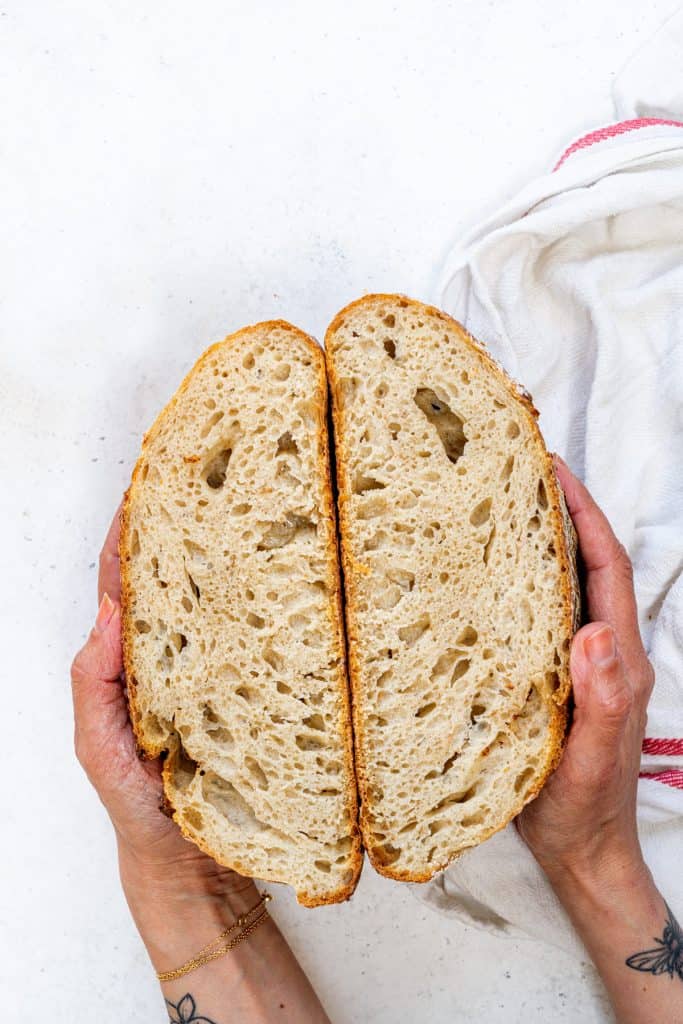
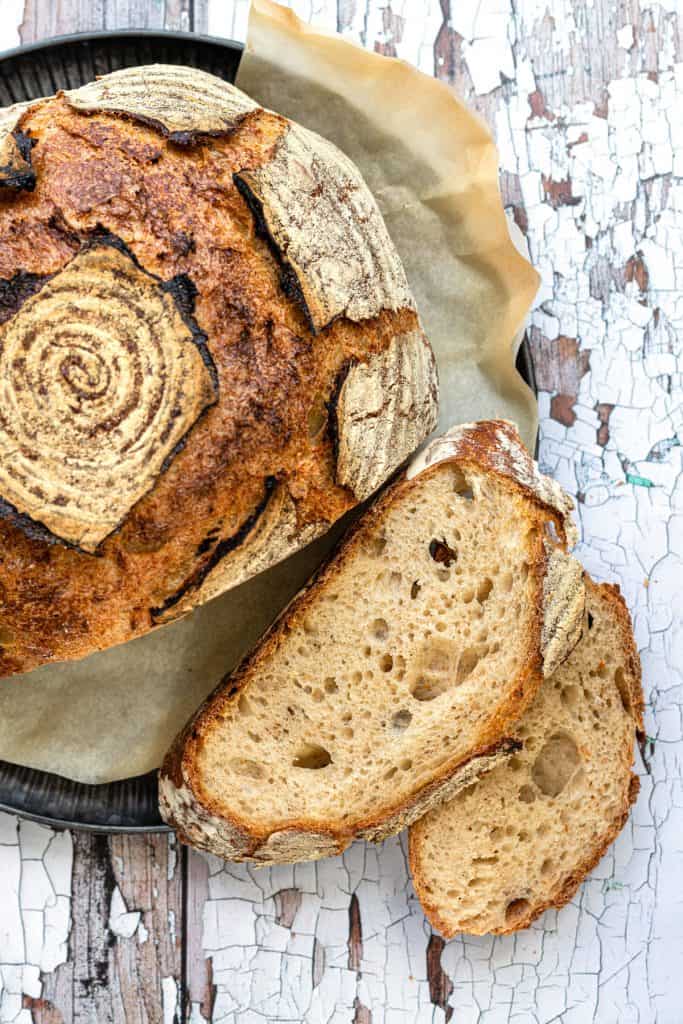
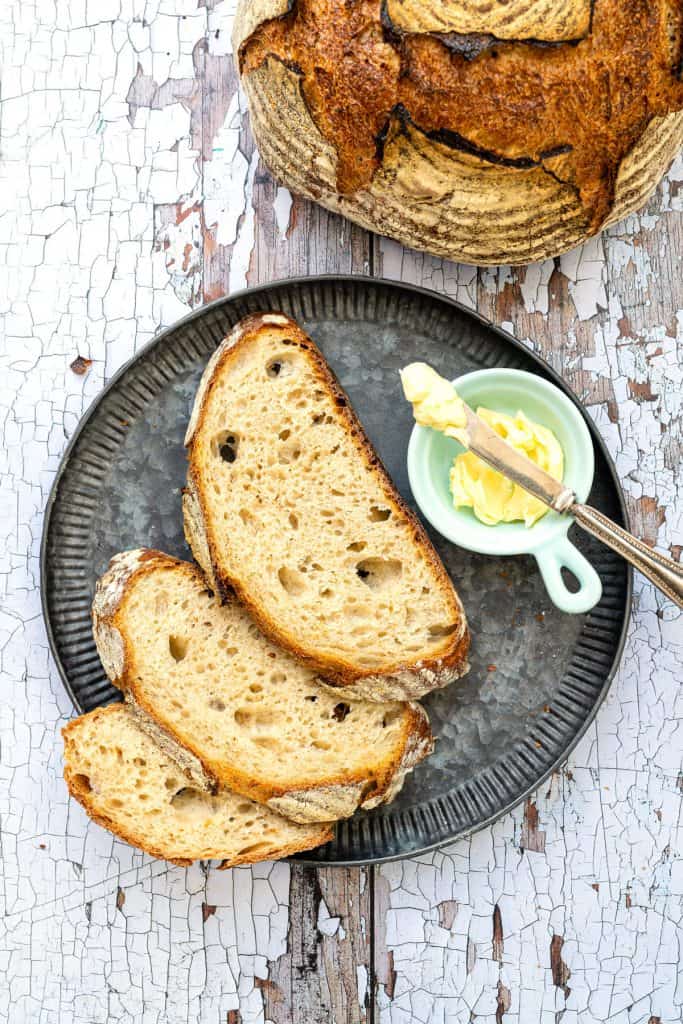
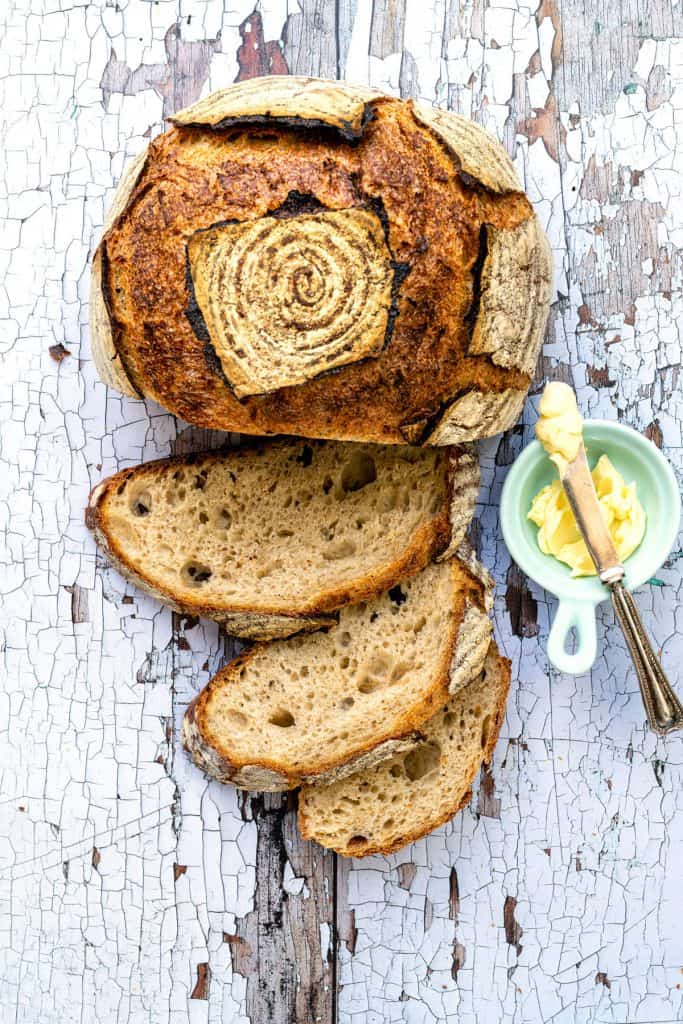
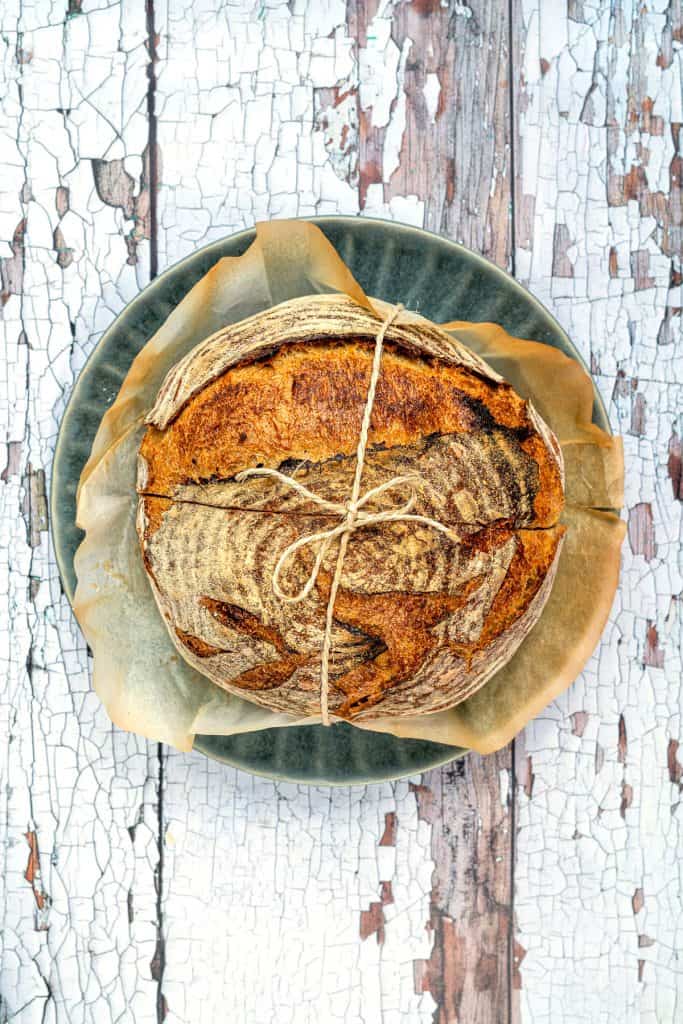
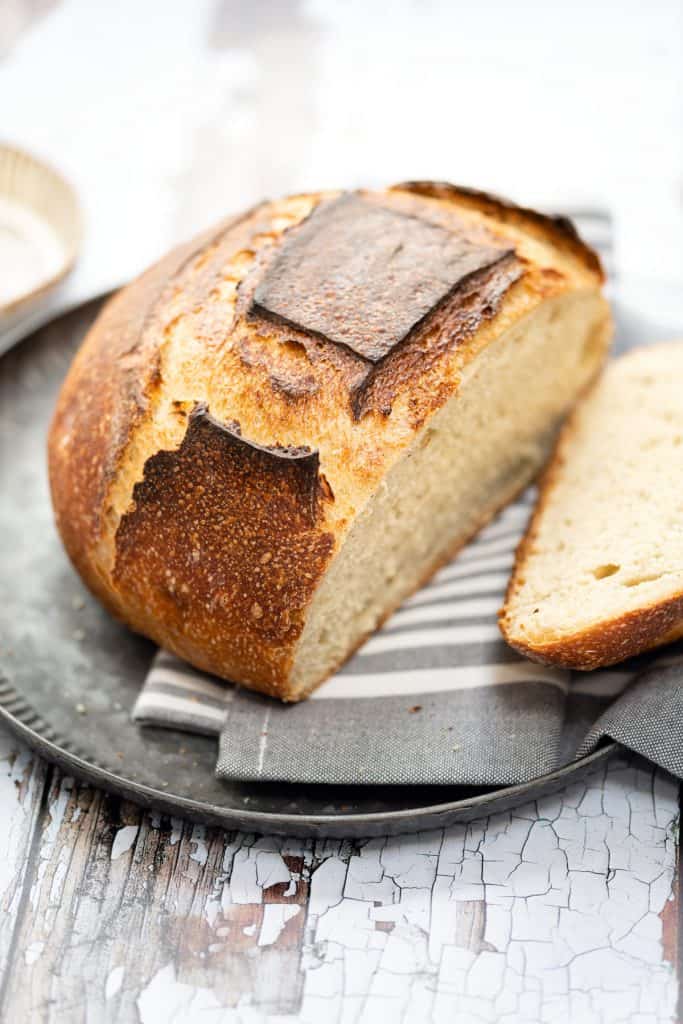

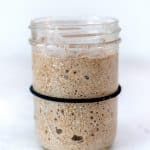

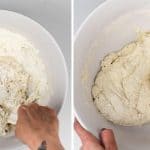
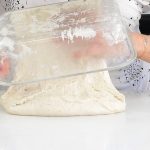
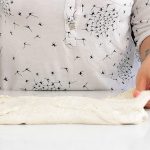
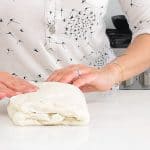
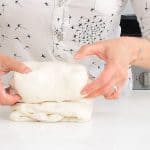
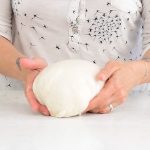
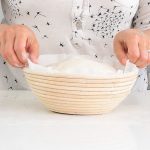
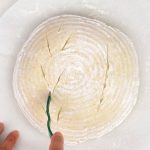
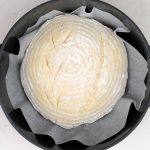
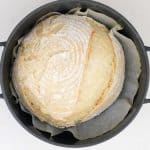
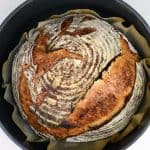
Mary says
My second try with sour dough bread. First was a different recipe, this one was much easier. It came out great but I probaly should of let it rise more the second time, I ran out of patience, but worth the effort definitely will make it again!! 😊
Aimee says
I have made this recipe twice. Looks beautiful, tastes great! Also fairly easy for sourdough. My problem is both times the loaves have burned on the bottom. Any suggestions on how to stop that?
Laura says
I have had luck putting my Dutch oven on a cookie sheet. The bottom has not burned.
Kait says
I put a baking sheet with water on the bottom shelf of my oven. it helps the bottom not burn but also isn’t too much water that the loaf doesn’t get too dense from the moisture.
Vicki E says
I fed my starter as per first instructions with the 60 g of flour and water. This am bubbly and passed float test but I only have about 112 g of starter this am- I assume I need to feed again but I don’t know what amounts to use and wondering why?
Lucy Parissi says
Hi Vicki – you can increase the amount to say 80g and do it once more. It should work with 112g starter but best work to the right amount x
Lou Ann M Agnelli says
This is a wonderful easy recipe
and the results are fabulous!Thank you for making this easy for beginners
Grace says
This sourdough turned out SO well!! I proofed mine in the fridge for 10ish hours and then on the warm counter for 5ish as my fridge was very very cold. The inside is perfect and the crust is too!
Lucy Parissi says
So glad! Thanks for the comment ❤️
Cindy L Berg says
I used this recipe for my first loaf of sourdough. I was so afraid that I would mess it up, but, wow, it came out great. The crust was crisp and brown and the inside was chewy and full of beautiful holes. I am now hooked on making sourdough every thing. Thank you for this simple method for delicious bread.
Sage says
So I can’t figure out what I’m doing wrong, I’ve done two loaves. The first one I did overnight, I left the dough out and proofed it for 11 hours, it had flattened in the glass dish I put it in but I folded it and everything, then left it for another 1.5 hours. Put it in my preheated dutch oven just as the instructions say. It came out only slightly golden, med/big air bubbles and kind of dense. Did I undercook it? Maybe over proof it? My other loaf I only proofed 7 hours because it looked really flat after the first proof, I folded and everything then proofed another 30mins. It got more golden and brown than the first loaf but it was still just as dense and had uneven air bubbles. Any help is greatly appreciated!
Lucy Parissi says
It’s hard to gauge without being there but I am wondering whether your starter is at full strength. It should rise to double its volume and pass the float test.
Uneven air bubbles are normal. Is the oven temperature right (Celsius or Fahrenheit?
Bella says
Hello Lucy, I would like to try your recipe tonight however I do not have a glass container. Can I use a baking pan? And do I need to prepare it in anyway? (Oil it or rinse with cold water)
Thank you in advance.
Lucy Parissi says
Hi Bella,
sorry I just saw your comment. When you say a glass container is this for proofing the dough? If so you can use any type of bowl, covered.
Melissa Lauher says
Can the second rise be done in the refrigerator?
Lucy Parissi says
Hi Melissa yes it can I left mine overnight (one in the oven as I type)
loretta says
Hello~
Trolling around looking for a way to use extra SD starter. I am currently almost to the end of my first overnight rise – realize this may not get an answer in time for this loaf…..but on the off chance…
Could I use this to make baguettes? Don’t see why not. Your thoughts?
Lucy Parissi says
I haven’t tried but I don’t see why not.
Carolyn says
I followed your recipe to the letter. My dough looked much drier than yours did to begin with-I added a bit more water as my starter had whole wheat in it. This morning the dough looks exactly like it did last night. There’s no way I’m going to be able to stretch it. I’ve got no idea what I could have done wrong. My starter was perfect. I did the ‘float’ test and then waited a bit more as the sourdough didn’t float the first time. Not too sure about this sourdough stuff!
Lucy Parissi says
Hi Carolyn – it’s hard to say what could be the issue here. But if the dough didn’t change at all it sounds as if the starter wasn’t strong enough
Carolyn says
I took it out of the refrigerator and let it sit out in my kitchen counter-although temp is only around 70 degrees. I also did the stretch and tuck for about 1-1/2 hrs. it did start to rise. I could see a difference as I stretched it. I put in in a banneton basket with parchment paper, and it rose. I just turned off the oven after it baked and am letting it sit in a hot oven for a bit. Saw that on another site. I’ll see how it looks tomorrow.
Jenna says
Great recipe! Very easy and bread came out perfect!
Lindsey says
Can this be used with whole wheat flour? I have good luck baking with a particular high quality whole wheat flour but I have never used with sourdough.
Lucy Parissi says
Yes but I wouldn’t use 100% wholewheat- try a mix of white and wholewheat otherwise I think it would be too heavy. I usually do 70-60 white and rest wholewheat
Wanda says
Easy with consistent results
Brendda says
Please convert your measurements of flour, water from metric to ounces or cups for those of us just learning
Thanks for an easy to follow guide for sourdough bread
Brenda
Lucy Parissi says
There are cup measurements provided
Michelle says
Not a hard conversion to do yourself given the blessing of Google. Also, as you learn more about bread making, there are strong recommendations to weigh your measurements rather than rely on volume.
Wendy says
I realize this is an old comment, but I’m responding for new readers. BUY A SCALE. They are easily under $20 and a valuable tool in the kitchen, especially for novices. Measuring by grams will consistently give you the best results and will save you from having to wash a sink load of dishes. You can use it to easily measure out things like mayonnaise or yogurt just by putting the container on the scale, taring it out (the scale will be zero with the mayo container on it) and then scoop out what you need. Note because you are subtracting from the container, you’ll have a negative number. So you need a Tbsp of mayo and that may be 30 grams, no need to get measuring spoons out that are difficult to use, just scoop out that amount-30g) on scale. Super simple and accurate every time.
Ann Newberry says
My first try, and it came out perfect! My grandkids loved it and asked me to bring more next weekend.
Saturday afternoon, I read many other recipes, surprised that a loaf of bread would take up to 3 days to make. When I found this one, with measurements in cups, I started it at 4 pm, and had a golden-crusted, warm loaf by 11 am to take with me.
Thank you!
Lucy Parissi says
I am so glad you all loved it ❤️❤️❤️
Manuela Galego says
No yeast used?
Lucy Parissi says
No this is sourdough bread so the sourdough starter is used instead of yeast
Wendell says
So good!
Michelle says
Really love this recipe, so straightforward but my dough always seems to be really sloppy and sticky and impossible to shape…it turns out fine mostly, but not sure what I’m doing wrong..??
Lucy Parissi says
Hi Michelle – maybe it needs a bit more flour? Add some when you are shaping the loaf.